
The common cold or the cold is a viral infectious disease of the upper respiratory tract that primarily affects the respiratory mucosa of the nose, throat, sinuses, and larynx. Signs and symptoms may appear fewer than two days after exposure to the virus. These may include coughing, sore throat, runny nose, sneezing, headache, and fever. People usually recover in seven to ten days, but some symptoms may last up to three weeks. Occasionally, those with other health problems may develop pneumonia.
In medicine, public health, and biology, transmission is the passing of a pathogen causing communicable disease from an infected host individual or group to a particular individual or group, regardless of whether the other individual was previously infected. The term strictly refers to the transmission of microorganisms directly from one individual to another by one or more of the following means:
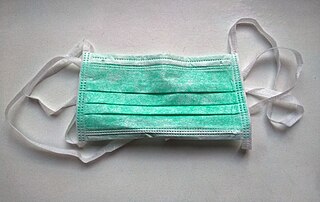
A surgical mask, also known by other names such as a medical face mask or procedure mask, is a personal protective equipment used by healthcare professionals that serves as a mechanical barrier that interferes with direct airflow in and out of respiratory orifices. This helps reduce airborne transmission of pathogens and other aerosolized contaminants between the wearer and nearby people via respiratory droplets ejected when sneezing, coughing, forceful expiration or unintentionally spitting when talking, etc. Surgical masks may be labeled as surgical, isolation, dental or medical procedure masks.

In infectious disease ecology and epidemiology, a natural reservoir, also known as a disease reservoir or a reservoir of infection, is the population of organisms or the specific environment in which an infectious pathogen naturally lives and reproduces, or upon which the pathogen primarily depends for its survival. A reservoir is usually a living host of a certain species, such as an animal or a plant, inside of which a pathogen survives, often without causing disease for the reservoir itself. By some definitions a reservoir may also be an environment external to an organism, such as a volume of contaminated air or water.
Aerosolization is the process or act of converting some physical substance into the form of particles small and light enough to be carried on the air i.e. into an aerosol. Aerosolization refers to a process of intentionally oxidatively converting and suspending particles or a composition in a moving stream of air for the purpose of delivering the oxidized particles or composition to a particular location.

Influenza, commonly known as "the flu" or just "flu", is an infectious disease caused by influenza viruses. Symptoms range from mild to severe and often include fever, runny nose, sore throat, muscle pain, headache, coughing, and fatigue. These symptoms begin one to four days after exposure to the virus and last for about two to eight days. Diarrhea and vomiting can occur, particularly in children. Influenza may progress to pneumonia from the virus or a subsequent bacterial infection. Other complications include acute respiratory distress syndrome, meningitis, encephalitis, and worsening of pre-existing health problems such as asthma and cardiovascular disease.

Airborne transmission or aerosol transmission is transmission of an infectious disease through small particles suspended in the air. Infectious diseases capable of airborne transmission include many of considerable importance both in human and veterinary medicine. The relevant infectious agent may be viruses, bacteria, or fungi, and they may be spread through breathing, talking, coughing, sneezing, raising of dust, spraying of liquids, flushing toilets, or any activities which generate aerosol particles or droplets.
Influenza prevention involves taking steps that one can use to decrease their chances of contracting flu viruses, such as the Pandemic H1N1/09 virus, responsible for the 2009 flu pandemic.
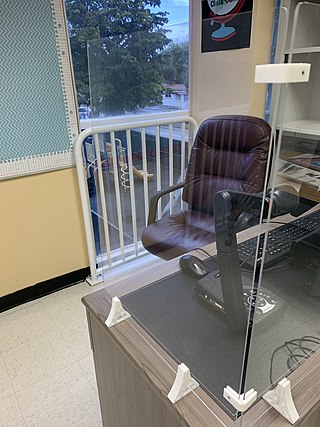
A sneeze guard, sneezeguard, or cough shield is an acrylic or glass screen designed to protect food or people from the exposure to respiratory droplets, which are dispensed when coughing, sneezing, or speaking. Sneeze guards have been in use in restaurants for decades. With the rise of the COVID-19 pandemic, sneeze guards have been installed in public places like offices, schools and retail stores to reduce the risk of infection through respiratory droplets.
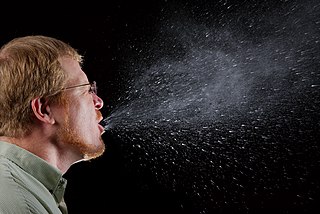
A respiratory droplet is a small aqueous droplet produced by exhalation, consisting of saliva or mucus and other matter derived from respiratory tract surfaces. Respiratory droplets are produced naturally as a result of breathing, speaking, sneezing, coughing, or vomiting, so they are always present in our breath, but speaking and coughing increase their number.
A toilet plume is the dispersal of microscopic particles as a result of flushing a toilet. Normal use of a toilet by healthy individuals is considered unlikely to be a major health risk. However this dynamic changes if an individual is fighting an illness and currently shedding out a virulent pathogen in their urine, feces or vomitus. There is indirect evidence that specific pathogens such as norovirus or SARS coronavirus could potentially be spread by toilet aerosols, but as of 2015, no direct experimental studies had clearly demonstrated or refuted actual disease transmission from toilet aerosols. It has been hypothesized that dispersal of pathogens may be reduced by closing the toilet lid before flushing, and by using toilets with lower flush energy.
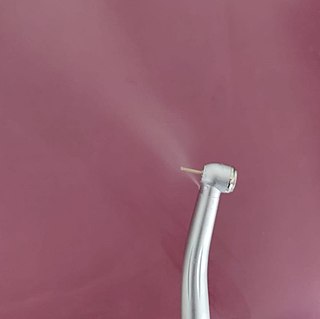
A dental aerosol is an aerosol that is produced from dental instrument, dental handpieces, three-way syringes, and other high-speed instruments. These aerosols may remain suspended in the clinical environment. Dental aerosols can pose risks to the clinician, staff, and other patients. The heavier particles contained within the aerosols are likely to remain suspended in the air for relatively short period and settle quickly onto surfaces, however, the lighter particles may remain suspended for longer periods and may travel some distance from the source. These smaller particles are capable of becoming deposited in the lungs when inhaled and provide a route of diseases transmission. Different dental instruments produce varying quantities of aerosol, and therefore are likely to pose differing risks of dispersing microbes from the mouth. Air turbine dental handpieces generally produce more aerosol, with electric micromotor handpieces producing less, although this depends on the configuration of water coolant used by the handpiece.

A cloth face mask is a mask made of common textiles, usually cotton, worn over the mouth and nose. When more effective masks are not available, and when physical distancing is impossible, cloth face masks are recommended by public health agencies for disease "source control" in epidemic situations to protect others from virus laden droplets in infected mask wearers' breath, coughs, and sneezes. Because they are less effective than N95 masks, surgical masks, or physical distancing in protecting the wearer against viruses, they are not considered to be personal protective equipment by public health agencies. They are used by the general public in household and community settings as protection against both infectious diseases and particulate air pollution.
An aerosol-generating procedure (AGP) is a medical or health-care procedure that a public health agency such as the World Health Organization or the United States Centers for Disease Control and Prevention (CDC) has designated as creating an increased risk of transmission of an aerosol borne contagious disease, such as COVID-19. The presumption is that the risk of transmission of the contagious disease from a patient having an AGP performed on them is higher than for a patient who is not having an AGP performed upon them. This then informs decisions on infection control, such as what personal protective equipment (PPE) is required by a healthcare worker performing the medical procedure, or what PPE healthcare workers are allowed to use.
Lydia Bourouiba is an Esther and Harold E. Edgerton Professor, an Associate Professor in the Civil and Environmental Engineering and Mechanical Engineering departments, and in the Institute for Medical Engineering and Science at the Massachusetts Institute of Technology. She is also a Harvard-MIT Health Sciences and Technology Faculty, and Affiliate Faculty of Harvard Medical School. She directs the Fluid Dynamics of Disease Transmission Laboratory at MIT.
Human-to-human transmission (HHT) is an epidemiologic vector, especially in case the disease is borne by individuals known as superspreaders. In these cases, the basic reproduction number of the virus, which is the average number of additional people that a single case will infect without any preventative measures, can be as high as 203.9. Interhuman transmission is a synonym for HHT.

Source control is a strategy for reducing disease transmission by blocking respiratory secretions produced through speaking, coughing, sneezing or singing. Surgical masks are commonly used for this purpose, with cloth face masks recommended for use by the public only in epidemic situations when there are shortages of surgical masks. In addition, respiratory etiquette such as covering the mouth and nose with a tissue when coughing can be considered source control. In diseases transmitted by droplets or aerosols, understanding air flow, particle and aerosol transport may lead to rational infrastructural source control measures that minimize exposure of susceptible persons.
William Firth Wells was an American scientist and sanitary engineer. In his early career, he pioneered techniques for the aquaculture of oysters and clams. He is best known for his work on airborne infections. Wells identified that tuberculosis could be transmitted through air via the nuclei of evaporated respiratory droplets, and developed the Wells curve to describe what happens to respiratory droplets after they have been expelled into the air.
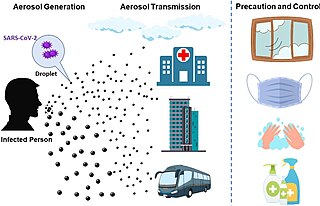
The transmission of COVID-19 is the passing of coronavirus disease 2019 from person to person. COVID-19 is mainly transmitted when people breathe in air contaminated by droplets/aerosols and small airborne particles containing the virus. Infected people exhale those particles as they breathe, talk, cough, sneeze, or sing. Transmission is more likely the closer people are. However, infection can occur over longer distances, particularly indoors.
Droplet nuclei are aerosols formed from the evaporation of respiratory droplets. They are generally smaller than 5 μm in diameter. Droplet nuclei are formed by the "dried residua of larger respiratory droplets". These particles are "the vehicle for airborne respiratory disease transmission, which are the dried-out residual of droplets possibly containing infectious pathogens". Diseases such as tuberculous and COVID-19 can be transmitted via droplet nuclei.













